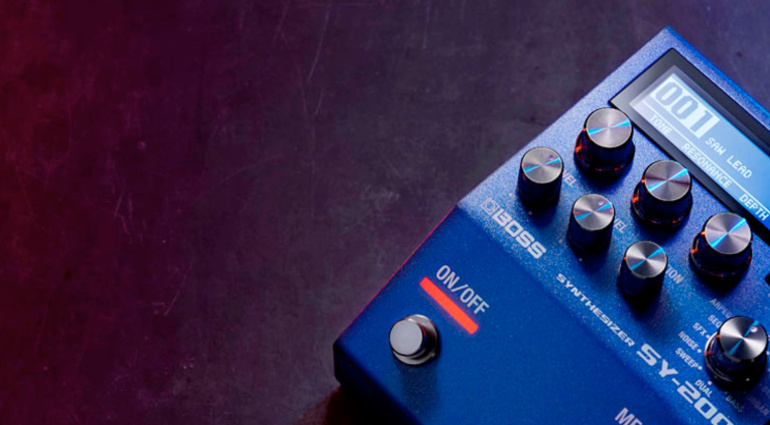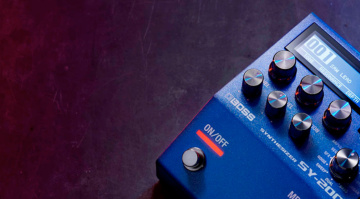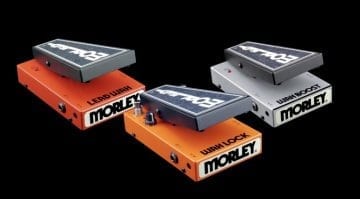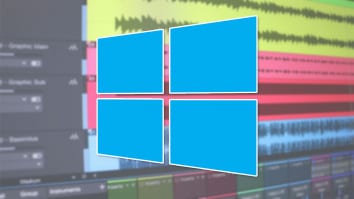The 6 Best Synth Pedals for Guitar and Bass: Sonic Explorations Between Retro and Futuristic
From funky bass synths to aetherial MK.Gee pad sounds!
What began as an experimental curiosity has evolved into a powerful creative tool, providing players with access to oscillators, filters, and arpeggiators directly from their pedalboards. In this guide, we’ll explore the best synth pedals and show you which one is the best one for you.
Our Picks:
How did we get here?
Synth pedals can open up a whole new world of sound for guitarists and bassists. It might come as a surprise to some, but the concept of converting a guitar into a synthesizer is not a new one. It dates back to the late 1960s and early 1970s, when engineers and musicians started combining electronic sound design with traditional instruments.
Early devices such as the Musitronics Mu-Tron III and the Roland GR-500 demonstrated what could be achieved, but they were bulky, expensive, and not the most reliable in terms of pitch tracking. By the late 1970s and early 1980s, analog synth pedals had become more accessible. Effects like the Electro-Harmonix Micro Synth and the Boss SYB-3 enabled musicians to produce synthesizer-like tones without the need for special pickups or external keyboards.
These pedals translated pitch into voltage, triggering filters, envelopes, and oscillators, a sound that would become synonymous with funk, new wave, and progressive rock. For bassists in particular, the deep, squelchy tones produced by these pedals became a staple of groove-driven styles.
The Best Synth Pedals: What to Look For
Modern guitar and bass synth pedals have come a long way. Many of today’s best synth pedals combine digital processing with analog warmth and access to authentic synth textures without requiring special pickups or complicated routing. These synth pedals allow you to blend your instrument’s natural tone with oscillators, filters, and responsive envelopes, while tracking pitch and amplitude with near-zero latency.
When looking for the best synth pedals, consider how you will actually use them. Would you prefer vintage analog-style sounds with thick monophonic leads or rather modern digital synth engines capable of polyphonic chords and full MIDI integration? Some synth pedals focus on classic subtractive synthesis and fat, Moog-like basses, while others lean into granular textures, sequencing or ambient soundscapes.
Also consider how much control you need on stage, since expression pedal inputs, presets, and MIDI connectivity can help you stay flexible. As always, these synth pedals are purely ranked by price.
Best Synth Pedals – The Budget Solution: Mooer E7
Compact yet impressively powerful, the Mooer E7 Polyphonic Guitar Synth delivers seven synth engines ranging from shimmering pads to punchy leads. Each preset has its own tweakable parameters (Attack, Speed, and High-/Low-Cut filters), so you can easily dial in tones.
The E7 also includes an arpeggiator, letting you add rhythmic motion to sustained notes and chords. And its polyphonic pitch-tracking is fast and reliable, so you can play complex harmonies without the need for a special pickup. Whether you’re exploring ambient soundscapes, funky leads, or cinematic layers, the Mooer E7 is the best entry-level synth pedal on the market. Check it out at Thomann*.
Electro-Harmonix KEY9 and MEL9
The Electro-Harmonix MEL9 and KEY9 transform your guitar or bass sound into a vintage keyboard. While the MEL9 emulates the iconic tape-based tones of the Mellotron (think flutes, choirs, and strings straight out of the Beatles’ Strawberry Fields Forever), the KEY9 comes loaded with sound from classic electric pianos like the Fender Rhodes and Wurlitzer. Both pedals feature simple controls for volume, effect mix, and attack.
For those who want to blur the line between guitar, synth, and keys, these pedals are among the best synth pedals on the market. Their polyphonic tracking is smooth, responding naturally to dynamics and phrasing. Whether you’re layering choir pads under clean chords or dropping funky Rhodes tones into a bass line, the MEL9* and KEY9* offer instant inspiration.
Source Audio C4
The Source Audio C4 Synth* is a modern classic among compact synth pedals. Designed for both guitar and bass, it offers four voices, multiple oscillator shapes, and an extensive selection of filters and envelope followers. SA’s Neuro Editor software is the secret weapon, opening up deep sound-design capabilities far beyond what’s available on the pedal itself.
Despite its powerful engine, the C4 is fairly intuitive for everyday use. Six onboard factory presets get you started instantly, while up to 128 patches can be recalled via MIDI for live use. Whether you desire vintage Moog-like tones, futuristic glitch textures, or something entirely different, the C4 Synth proves that synth pedals can offer the same level of expressiveness and creativity as full-size synthesizers.
Boss SY-Series
As in many other pedal categories, Boss absolutely dominates synth pedals. Their SY-Series includes the compact SY-1* in the usual Boss pedal format, the SY-200* offering 128 presets and a display, and the mighty SY-1000*. This is pretty much the be-all and end-all of synth pedals in terms of quality and versatility. It might be one of the best synth pedals, but it’s certainly the biggest one.
But it does not stop there. Besides the SY-series, Boss also has the GM-800 and the VG-800. Compared to the SY-Series, these rely on Boss’ dedicated synth pickups. That might be overkill for some, but it also get you sounds and a tracking performance that’s unmatched. No matter what type of synth pedal you’re looking for, Boss has got you covered.
MXR MB301 Bass Synth
The MXR MB301 Bass Synth delivers the fat, funky low-end growl of vintage analog synthesizers in a pedal for modern bassists. Developed in collaboration with the renowned bassist Ian Allison, it produces those “intergalactic groove” tones reminiscent of classic 1970s funk and fusion. With controls for mix, cutoff, envelope, sub mix, resonance, and mod, it provides all the controls you need to dial in your sound from smooth filter sweeps to punchy, resonant basslines.
What really stands out is how musical and responsive the MB301 feels. Whether you’re chasing Bootsy-style funk, modern electronic textures, or layered synth bass pads, the MB301 fits seamlessly into your setup. It’s a very well-built and thought-out example of how the best synth pedals can bridge the gap between electronic sound design and the feel of an acoustic instrument. It’s available at Thomann*.
Best Synth Pedals: The Mighty Meris Enzo X
While the Meris Enzo was already in a league of its own, the recent upgrade Meris Enzo X redefines what a synth pedal can be. It’s essentially a modular synthesizer in stompbox form. It features a color display, expanded modulation options, and fully polyphonic pitch tracking. With five synth modes and selectable oscillator waveforms such as saw, triangle, and square, you can create everything from lush pads to gritty evolving leads.
You can even play it like a synth via MIDI, use your guitar as a sound source, or integrate it into a larger modular setup. ADSR envelopes, real-time modulation, onboard flanger and phaser effects, and 99 preset slots make the Enzo X just as powerful as many desktop synths. For players who are looking for a single device for ambient sound design, electronic textures, and futuristic tone shaping, the Enzo X is a clear contender for the best synth pedal available today. Check it out at Thomann*.
*Disclaimer: This post contains affiliate links and/or widgets. When you buy a product via our affiliate partner, we receive a small commission that helps support what we do. Don’t worry, you pay the same price. Thanks for your support!
 4,8 / 5,0 |
4,8 / 5,0 | 







